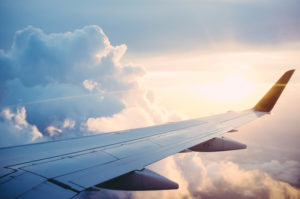
In years gone by, jet setting across the globe was considered a rare treat. Nothing was more glamorous, more capable of attracting the envy of friends and family than to return home after lying for days on end on the warm sand of a Caribbean island, with a sun-kissed glow and the photos to prove it. These days, the game has changed. The world has never been so small, with the airline industry shuttling an estimated 3 billion passengers annually across cities, countries and continents.
This heightened mobility comes at a cost, however, as air travel soars above other modes of transportation in terms of energy inefficiency, with sky-high carbon emissions. There are approximately 20,000 commercial jets servicing globe-trotters today, accounting for 11% of the greenhouse gases spurted out by the worldwide transportation sector. In the United States, transportation now claims the crown in terms of emissions, toppling power plants who’ve sat on that ignoble throne for the previous four decades. The footprint is only expected to climb higher and higher in the coming years, with air travel doubling its emissions by 2050 and the international jet fleet ballooning to include 50,000 commercial aircrafts by 2040.

Confronted with this information, what’s an environmentally conscious person to do? There are those out there who begin to sound like the Sex Ed teachers of old, preaching the gospel of abstinence as the only sure-fire way to avoid unsightly warts on the Earth’s ozone. “Don’t fly,” they exhort. “Stay home and read about the undulating sand dunes of the Sahara, or the hypnotizing glacial caverns of Iceland.” Such advice is like giving a fork to a kid in a cast and telling him not to scratch the itch with it. All humans, to a greater or lesser degree, are naturally nomadic creatures. There’s an urge to explore, to experience, and to expand our horizons.
There are other, more realistic steps concerned travelers can take. First, steer clear of first class, and instead hunker down in steerage. Flyers who squeeze themselves into coach on a round-trip flight from New York to Los Angeles emit almost 1 metric ton of carbon dioxide into the atmosphere. That’s no small blip on the radar, equaling about 20% of the annual carbon emissions of the average American driver in less than a 10 hour flight. Still it could be worse: first class passengers, with all that extra leg room, emit almost three times as much carbon dioxide.
Next, do your research! More and more airlines are offering their customers the opportunity to offset their carbon footprints by donating to causes that help protect the environment. For approximately $10 American, you can help reforestation efforts in Chile that will effectively balance out the emissions of that trip from JFK to LAX. Also, thanks to watchdog groups like the International Council on Clean Transportation (ICCT), you can choose to reward good behavior; in 2016, the ICCT found that Alaska Airlines was the most efficient American airline for the seventh year running, while Virgin America ranked last on the list.

There’s a reason Alaska Airlines is flying high: they made the hard choices that enabled them to be 26% more fuel efficient than their competition over at Virgin. The same is true for the individual. You may feel like a high roller if you jump on a jet for a trip from Los Angeles to Las Vegas for the weekend, but you’re gambling with the welfare of the planet. For shorter trips, it’s much more efficient to drive than to fly. According to NASA, 25% of an airplane’s emissions come from taking off and landing. Once a plane hits a certain elevation, it cruises and doesn’t require as much fuel, so for longer journeys you don’t have to feel guilty while watching that in-flight movie.
Finally, believe that you can make a difference. Sitting in the cabin, as the engines begin to rev and your seat shakes slightly, hiding the trembling of your hand from your fear of flying, you may look around and start to wonder, “I paid for the offset that supports wind farms in Texas, but how many of these other folks forked up the extra cash?” Take a deep breath and relax. Like airplanes, it takes a little extra energy to get a good idea off the ground, but once up in the air, it’s clear, blue skies without a cloud in sight.
Take, for example, the recent leaps and bounds made by scientists who are attempting to create electric-powered airplanes. The tradition goes back 100 years when, in 1918, Austro-Hungarian scientists created an all-electric helicopter that could climb to an elevation of 50 meters- all while tethered to a ground electrical source. These days, scientists are attempting to forgo the plug and figure out a way to get battery-powered planes off the ground. The problem is, batteries weigh substantially more than fuel. Stay tuned to learn about the brilliant ways in which visionaries are lightening the load and creating the future of air travel!



